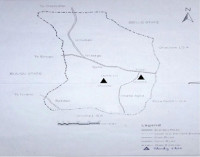Baseline Epidemiological Assessment of Urinary Schistosomiasis among School Children in Okpoto District, Southeast Nigeria https://dx.doi.org/10.4314/njpar.v43i2.8
Main Article Content
Abstract
This cross-sectional survey was set out to identify and describe urinary schistosomiasis and associated factors among schoolaged children in a rural Okpoto District, Ebonyi State, Nigeria; given the relevance and scarce scientific information about the epidemiology of the infection in the area. Sedimentation and light microscopic methods were used to examine 180 urine samples of randomly selected school-aged children from three primary schools in the community for Schistosoma haematobium eggs. While relevant epidemiological data were collected using questionnaires, further laboratory investigations were conducted to estimate the amount of blood in the urine. The result of urine microscopy showed that 10 % of all the specimens examined were positive for S. haematobium, amongst which a prevalence of 16.7 % was recorded amongst males and 6.7 % among females. The prevalence of infection with S. haematobium was higher in the group 9-12 years (14.1 %) than in the 5-8 years age group (6.3 %); while Central School Lobasa had 6.6 %, Ukwuachi Primary School had 23.3 % and none detected among pupils from Ndieze Primary School. Results of the urine reagent strip showed 0 %, 20 % and 0 % positives in pupils from Central School Lobasa, Ukwuachi Primary School, and Ndieze Primary School, respectively. The outcome of this investigation confirmed that urine containing blood contains schistosome eggs. The related environmental, as well as host behavioural factors identified in this study, suggest that the overall prevalence of schistosomiasis in this area could be fast-increasing, with attendant morbidity and mortality implications. This effort, therefore, provides an appropriate basis for further investigation; urgent implementation and sustenance of relevant control interventions.
Article Details

This work is licensed under a Creative Commons Attribution-NonCommercial-NoDerivatives 4.0 International License.
References
Steinmann, P. (2006). Schistosomiasis and water resources development: Systematic Review, meta-analysis, and estimates of people at risk. The Lancet Infectious Diseases, 6(7):411-425.
Hotez, P.J., Kamath, A. (2009). Neglected tropical diseases in sub-Saharan Africa: a
review of their prevalence, distribution, and disease burden. PLOS 1 Neglected Tropical Diseases 3:e41
Chitsulo, L., Engels, D., Montresor, A., Savioli, L. (2000). The global status of schistosomiasis and its control Acta Tropica, 77(1):41-51.
Engels, D. (2002). The global epidemiological situation of schistosomiasis and new approaches to control and research. Acta Tropica, 82(2):139-146.
WHO (2002). Prevention and control of schistosomiasis and soil-transmitted helminthiasis. Report of a WHO Expert Committee. Geneva, World Health Organization (WHO Technical Report Series, No. 912).
Dawaki, S., Al-mekhlafi, H. M., Ithoi, I., Ibrahim, J., Abdulsalam, A. M., Ahmed, A., Sady, H., Atroosh, W. M., Al-areeqi, M.A., Elyana, F. U., Nasr, N. and Surin, J. (2016). Prevalence and risk factors of schistosomiasis among Hausa communities in Kano State, Nigeria. Revista Instituto Medicina Tropical Sao Paulo, (58): 54.
Zang, Y., MacArthur, C., Mubila, L., Baker, S. (2010). Control of neglected tropical diseases needs a long-term commitment. BMC Medicine (8):67.
. Ansell, C., Gash, A. (2001). Collaborative governance in theory and practice. Journal
of Public Administration Research & Theory 18: 545-571
Nworie, O.,Anya, O.,Anyim, C., Okoli, C. S. and Okonkwo, E. C. (2012). Prevalence of urinary schistosomiasis among primary school children in Afikpo North Local Government Area of Ebonyi State. Annals of Biological Research, 3(8):3894-3897.
Umoh, N. O., Nwamini, C. F., Inyang, N. J., Umo, A. N., Usanga, V. U., Nworie, A., Elom, M. O. and Ukwah, B. N. (2020). Prevalence of urinary schistosomiasis amongst primary school children in Ikwo and Ohaukwu Communities of Ebonyi State, Nigeria. African Journal of Laboratory Medicine, 9(1): 812.
Ezeadila, J.O., Okoli, I., Agomuo, M., Aneke, F. C., and Egbuche, C. M. (2015).
Prevalence of urinary schistosomiasis among community primary school pupils in
Amagunze, Enugu State, Nigeria. World Rural Observatory, 7(3): 46-51.
Okeke, O. C. and Ubachukwu, P. O. (2013). Urinary schistosomiasis in urban and semi-urban communities in SouthEastern Nigeria. Iranian Journal of Parasitology, 8 (3): 467-473
Uneke, C., Ugwok-Adibuah, S., Nwakpu, K., Ngwu, B. (2009). An assessment of
Schistosoma haematobium infection and urinary tract bacterial infection amongst
school children in rural eastern Nigeria. The Internet Journal of Laboratory Medicine,(4):1.
Ekpo, U. K., Laja-Deile,A., Oluwole,A. S., Sam-Wobo, S. O. and Mafiana, C. F. (2010). Urinary Schistosomiasis among preschool children in a rural community near Abeokuta Nigeria. Parasites and Vectors (3):58.
Anosike, J. C., Nwoke, B. E. B., Njoku, A. J. (2001). The validity of haematuria in the Community diagnosis of urinary schistosomiasis infections. Journal of helminthology. (75): 223-225.
Afiukwa, F. N., Nwele, D. E., Uguru, O. E., Ibiam, G. A., Onwe, C. S., Ikpo, A. U., Agumah, N. B., and Odoemena, O. F. (2019). Transmission Dynamics of
Urogenital Schistosomiasis in the Rural Community of Ebonyi State, Southeastern
Nigeria. Journal of Parasitology Research, https://doi.org/10.1155/2019/7596069.
Chiamah, O.C, Ubachukwu, P.O,Anorue, C. O, Ebi. S. (2019). Urinary schistosomiasis in Ebonyi State, Nigeria from 2006 to 2017. Journal of Vector Borne
Diseases, 5(6): 87-91.
Nwosu, D. C., Obeagu, E. I., Ozims, S. J., Ezeama, M. C. and Uduji, H. I. (2015).
Prevalence of Urinary Schistosomiasis Infection among Primary School Pupils in
Ezza-North Local Government Area of Ebonyi State. International Journal of Current Microbiology and Applied Science 4(5): 1151-1157.
Ivoke, N., Ivoke, O. N., Nwani, C. D., Ekeh, F. N., Asogwa, C. N., Atama, C. I., and Eyo, J. E. (2014). Prevalence and transmission dynamics of Schistosoma haematobium infection in rural community of south-western Ebonyi State, Nigeria.
Tropical Biomedicine, 31(10): 1-12.
Ezeh, C. O., Onyekwelu, K. C. and Akinwale, O. P. (2019). Urinary schistosomiasis in Nigeria: a 50-year review of prevalence, distribution, and disease burden. Parasite, (26) 19. doi:10.1051/parasite/2019020
Van Tong, H., Brindley, P. J., Meyer, C. G., and Velavan, T. P. (2017). Parasite
Infection, Carcinogenesis, and Human Malignancy. EBioMedicine, (15), 12–23. https://doi.org/10.1016/j.ebiom.2016.11.03 4


